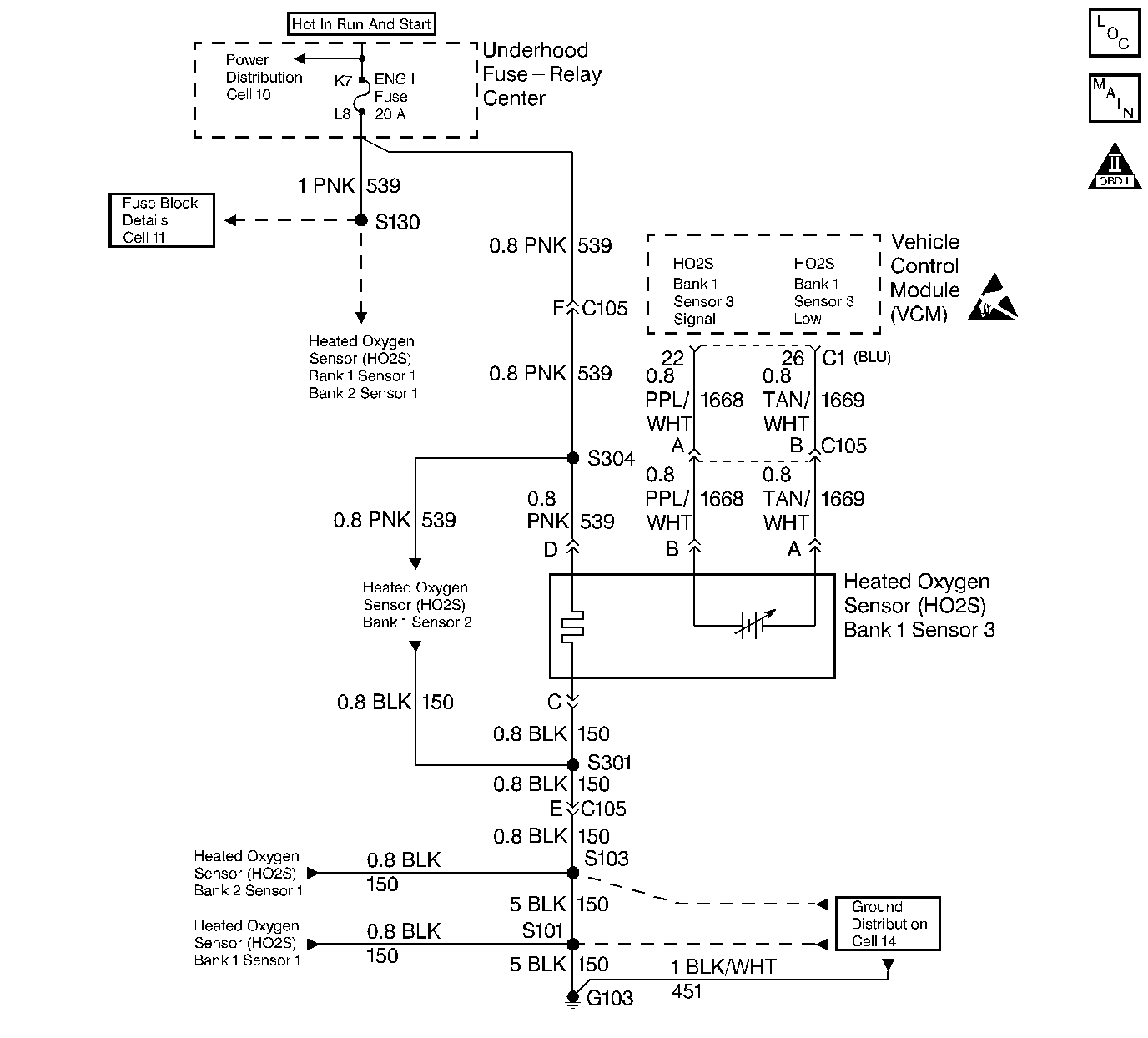
Circuit Description
Important: If the voltage is measured with a 10 megohm digital voltmeter, the voltage may read as low as 0.32 volt.
The VCM supplies a voltage of approximately 0.45 volts (450 mV) between the HO2S High and the HO2S Low circuits. The Heated Oxygen Sensor (HO2S) varies the voltage from approximately 1.0 volt (1000 mV) during rich conditions to 0.10 volt (100 mV) during lean conditions.
The VCM monitors the Heated Oxygen Sensor (HO2S) activity for 100 seconds after a Closed Loop. During the monitor period, the VCM counts the number of times that the HO2S switches from rich to lean and from lean to rich and adds the amount of time it took to complete all switches. With this information, an average time for all of the switches can be determined. If the average time to switch is too slow, a DTC P0146 sets.
When the HO2S temperature is below 360°C (600°F), the sensor will not produce any voltage. The sensor will also behave like an open circuit. This will result in an Open Loop operation.
The HO2S heater provides for a faster sensor warm-up which allows the sensor to become active in a shorter period of time and remain active during a long extended idle. The DTC P0146 determines if the HO2S is functioning properly by checking the response time of the sensor. This is a type B DTC.
Conditions for Setting the DTC
The following conditions will set the DTC:
| • | No TP sensor DTCs |
| • | No EVAP DTCs |
| • | No IAT sensor DTCs |
| • | No MAP sensor DTCs |
| • | No ECT sensor DTCs |
| • | No MAF sensor DTCs |
| • | No intrusive test in progress |
| • | No device controls active |
| • | The system voltage measures at least 9.0 volts |
| • | The engine run time is greater than 2 minutes |
| • | The HO2S voltage is greater than 0.299 volts (299 mV), and less than 0.598 volt (598 mV). For the 7.4L the HO2S voltage is greater than 0.399 volts (399 mV), and less than 0.468 volts (468 mV) |
HO2S Sensor Open Test Enable
| • | The engine run time is greater than 2 minutes. |
| • | A Closed Loop exists. |
| • | The DTC P0146 (HO2S heater) is not set. |
| • | The HO2S voltage is greater than 0.351 volts but less than 0.473 volts. |
Action Taken When DTC Sets
The VCM turns the MIL ON after the second test failure.
Conditions for Clearing the MIL/DTC
The VCM turns OFF the MIL after 3 consecutive driving trips without a fault condition present. A history DTC will clear if no fault conditions have been detected for 40 warm-up cycles (the coolant temperature has risen 22°C (40°F) from the start-up coolant temperature and the engine coolant temperature exceeds 71°C (160°F) during that same ignition cycle) or the scan tool clearing feature has been used.
Diagnostic Aids
Check the HO2S heater operation.
Never solder the HO2S wires. For proper wire and connector repairs, refer to Wiring Repairs .
Test Description
The numbers below refer to the step numbers in the diagnostic table.
-
This step checks for other DTCs.
-
This step checks for physical damage to engine components and converter.
Step | Action | Value(s) | Yes | No |
|---|---|---|---|---|
1 |
Important: Before clearing DTCs, use the scan tool in order to record freeze frame and the failure records for reference because the Clear Info function will lose the data. Was the Powertrain On-Board Diagnostic (OBD) System Check performed? | -- | ||
Are any other HO2S DTCs stored? | -- | Go to The Applicable DTC Table | ||
3 |
Is the MAP sensor voltage greater than the specified value? | 4.0 V | Go to DTC P0108 Manifold Absolute Pressure (MAP) Sensor Circuit High Voltage | |
Visually and physically check the exhaust system (near HO2S Bank 1, Sensor 1) for leaks. Was a problem found? | -- | |||
5 | Visually and physically check that the HO2S (Bank 1, Sensor 3) is installed securely. Was a problem found? | -- | ||
6 | Check that the HO2S (Bank 1, Sensor 3) connection is not contacting the engine or the exhaust system. Was a problem found? | -- | ||
7 |
Is a sensor contamination evident? | -- | Go to Diagnostic Aids | |
8 | Repair as necessary. Is the action complete? | -- | -- | |
9 | Repair the source of HO2S (Bank 1, Sensor 3) contamination. Is the action complete? | -- | -- | |
10 | Replace the HO2S (Bank 1, Sensor 3). Refer to Heated Oxygen Sensor (HO2S) Replacement . Is the action complete? | -- | -- | |
11 |
Does the scan tool indicate that this diagnostic ran and passed? | -- | ||
12 | Using the scan tool, select the Capture Info and the Review Info. Are any DTCs displayed that have not been diagnosed? | -- | Go to The Applicable DTC Table | System OK |
